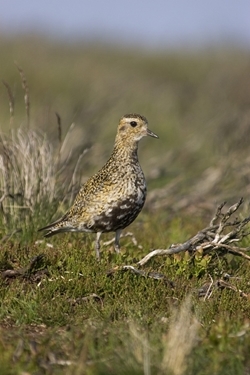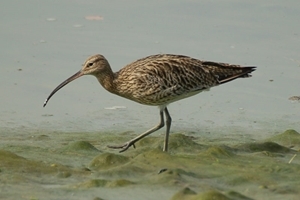Key points
- The Berwyn is an important area of blanket bog and heather moorland designated as a Special Area for Conservation (SAC) and a Special Protection Area (SPA) for the upland birds that live there.
- Moorland management in the area has changed in the last century, with driven grouse shooting ceasing in the late 1990s.
- This study looked at changes in local bird populations between two surveys in 1993 and 2002, and longer-term changes in red grouse numbers from shooting bag records.
- Red grouse numbers have fallen to very low levels.
- Lapwing have been lost and no longer breed in the Berwyn area. Golden plover numbers have dropped by 90%, curlew by 79% and ring ouzel by 80%. Hen harrier numbers have halved.
- Meadow pipit and whinchat numbers have doubled, and there were almost ten times as many stonechat in 2002 compared to 1983-85. There were five times as many carrion crows, three times as many ravens, seven times as many peregrine falcons and more than twice as many buzzards.
- Skylark, wheatear, merlin, red kite, short-eared owl, and kestrel numbers have not changed.
Background
 Berwyn Special Area for Conservation is an area of moorland in North Wales that is designated to protect its blanket bog. Heather moorland like that on Berwyn is an important and rare habitat, which is disappearing. Between 1946 and 1984 almost half the heather moorland in Wales, and 39% of that in the Berwyn area, was lost due to overgrazing by sheep or because of commercial forestry.
Berwyn Special Area for Conservation is an area of moorland in North Wales that is designated to protect its blanket bog. Heather moorland like that on Berwyn is an important and rare habitat, which is disappearing. Between 1946 and 1984 almost half the heather moorland in Wales, and 39% of that in the Berwyn area, was lost due to overgrazing by sheep or because of commercial forestry.
Since 1998, Berwyn has been a Special Protection Area (SPA) for hen harriers, red kite, merlin, and peregrine falcon, and it is also designated as a Site of Special Scientific Interest (SSSI) because of the entire bird community, which includes black grouse, curlew and golden plover. Following the Second World War, moorland management for red grouse declined until, by the late 1990s, driven grouse moor management had ceased.
What they did
The scientists used shooting records from 1880 to 2011 to study the number of red grouse shot per year on three Berwyn moors, and a moor on the neighbouring Ruabon mountain. Grouse were also counted using pointing dogs on four moors between 1995 and 2010.
To study the wider bird community on Berwyn and understand how the changes in management have affected other birds that live there, the scientists used results from Natural Resources Wales bird surveys that had been conducted in 1983-85 and in 2002. They compared the results from 14 sites, containing 107 one-kilometre squares surveyed between 1983-85 with results from the sites that were re-surveyed in 2002. The repeat surveys were carried out at the same time of year as the first surveys (within a week of the original dates) and involved two observers walking a straight, parallel line (‘transect’) across the square, 200m apart. Each bird seen was marked on a map. Each plot was visited twice, once in April/May and again in June.
What they found
Red grouse
Red grouse numbers were highest in the early 1900s, with the most shot being an average 250 birds per square kilometre. This number gradually fell, with sharp drops during the First and Second World Wars. The number rose a little to 43 birds per square kilometre in the 1970s, but fell to fewer than five shot per square kilometre by the 1990s.
Red grouse were also included in the bird surveys in 1983-85 and 2002, with numbers halving between the two surveys.
Other moorland birds
 Between 1983-85 and 2002, lapwing were lost completely from the Berwyn study area, golden plover declined by 90%, ring ouzel by 80%, and curlew by 79%. The number of meadow pipits doubled, whinchat more than doubled (124% increase), and there were almost ten times as many stonechat. The number of skylark and wheatear remained the same.
Between 1983-85 and 2002, lapwing were lost completely from the Berwyn study area, golden plover declined by 90%, ring ouzel by 80%, and curlew by 79%. The number of meadow pipits doubled, whinchat more than doubled (124% increase), and there were almost ten times as many stonechat. The number of skylark and wheatear remained the same.
There were five times as many carrion crows in 2002 as there had been in 1983-85, and three times as many ravens. There were seven times as many peregrines, more than twice as many buzzards (150% increase), but half the number of hen harriers. Numbers of merlin, red kite, short-eared owl, and kestrel all remained the same. Black grouse dropped by three quarters. Overall, two thirds of red-listed species in Wales dropped in number.
As well as the number of birds, the scientists also looked at their distribution and found that the number of areas occupied by red grouse, lapwing, and curlew declined between 1983-85 and 2002, whereas stonechat, raven, buzzard, and peregrine were more widespread by 2002.
What does this mean?
Driven grouse moor management ceased on Berwyn Special Area for Conservation in the late 1990s, and red grouse are now found there in much smaller numbers. They are now on the Red-list of Birds of Conservation Concern in Wales. In other areas of the UK where grouse moor management continues, such as the North of England, red grouse are still found at higher densities.
This is also the case for breeding waders such as curlew and lapwing, with one study finding three to five times higher densities on managed grouse moors than on unmanaged moorland. Since driven grouse moor management stopped on Berwyn, breeding populations of several wader species have severely declined and lapwing have been lost altogether. It is thought that the combination of heather management, which keeps the vegetation at a shorter level that breeding waders prefer, and predator control, which eases the predation pressure on other species as well as grouse, combine to give better conditions for breeding waders on grouse moors.
The decline of breeding waders in Berwyn is of major conservation concern, and to prevent more local extinctions such as that seen for lapwing, moorland management to support these species should be reintroduced.
Read the original abstract
Warren, P., & Baines, D. (2014) Changes in the abundance and distribution of upland breeding birds in the Berwyn Special Protection Area, North Wales 1983-2002. Birds in Wales, 11: 32-42.